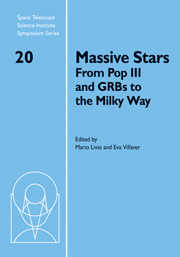Book contents
- Frontmatter
- Contents
- Participants
- Preface
- High-mass star formation by gravitational collapse of massive cores
- Observations of massive-star formation
- Massive-star formation in the Galactic center
- An x-ray tour of massive-star-forming regions with Chandra
- Massive stars: Feedback effects in the local universe
- The initial mass function in clusters
- Massive stars and star clusters in the Antennae galaxies
- On the binarity of Eta Carinae
- Parameters and winds of hot massive stars
- Unraveling the Galaxy to find the first stars
- Optically observable zero-age main-sequence O stars
- Metallicity-dependent Wolf-Rayet winds
- Eruptive mass loss in very massive stars and Population III stars
- From progenitor to afterlife
- Pair-production supernovae: Theory and observation
- Cosmic infrared background and Population III: An overview
Unraveling the Galaxy to find the first stars
Published online by Cambridge University Press: 04 August 2010
- Frontmatter
- Contents
- Participants
- Preface
- High-mass star formation by gravitational collapse of massive cores
- Observations of massive-star formation
- Massive-star formation in the Galactic center
- An x-ray tour of massive-star-forming regions with Chandra
- Massive stars: Feedback effects in the local universe
- The initial mass function in clusters
- Massive stars and star clusters in the Antennae galaxies
- On the binarity of Eta Carinae
- Parameters and winds of hot massive stars
- Unraveling the Galaxy to find the first stars
- Optically observable zero-age main-sequence O stars
- Metallicity-dependent Wolf-Rayet winds
- Eruptive mass loss in very massive stars and Population III stars
- From progenitor to afterlife
- Pair-production supernovae: Theory and observation
- Cosmic infrared background and Population III: An overview
Summary
I review our knowledge of metal-free stars in the early universe—based on highly detailed new data on the most metal-poor stars in the Galaxy, and interpreted with new models of nucleosynthesis and chemical evolution. Present data supports the theoretical prediction that metal-free gas did not form stars of M ∼ 1 M⊙, but indicates a characteristic mass M ∼ 10 M⊙, lower than the M ∼ 100 M⊙ suggested by ab initio simulations. This field is expected to grow dramatically in the next decade with future instruments and large surveys of metal-poor Galactic stars.
Introduction and motivations
Despite theoretical progress and rapid advances in the discovery of high-redshift galaxies, many questions about the first stars remain open: What was their IMF? How long did the epoch of metal-free stars last? Did they contribute much to reionization? Do their remnants include compact objects, and if so, where are they? The highly interdisciplinary “first stars” field is just beginning to confront observations in the form of reionization tests with the Gunn-Peterson effect and the Wilkinson Microwave Anisotropy Probe (WMAP), and chemical abundances from extremely metal-poor Galactic stars. These indicators have yielded some indirect constraints on the nature of the first stars. I believe that neither high-z galaxies nor the “second stars” will tell the whole story on their own.
- Type
- Chapter
- Information
- Massive StarsFrom Pop III and GRBs to the Milky Way, pp. 152 - 166Publisher: Cambridge University PressPrint publication year: 2009



